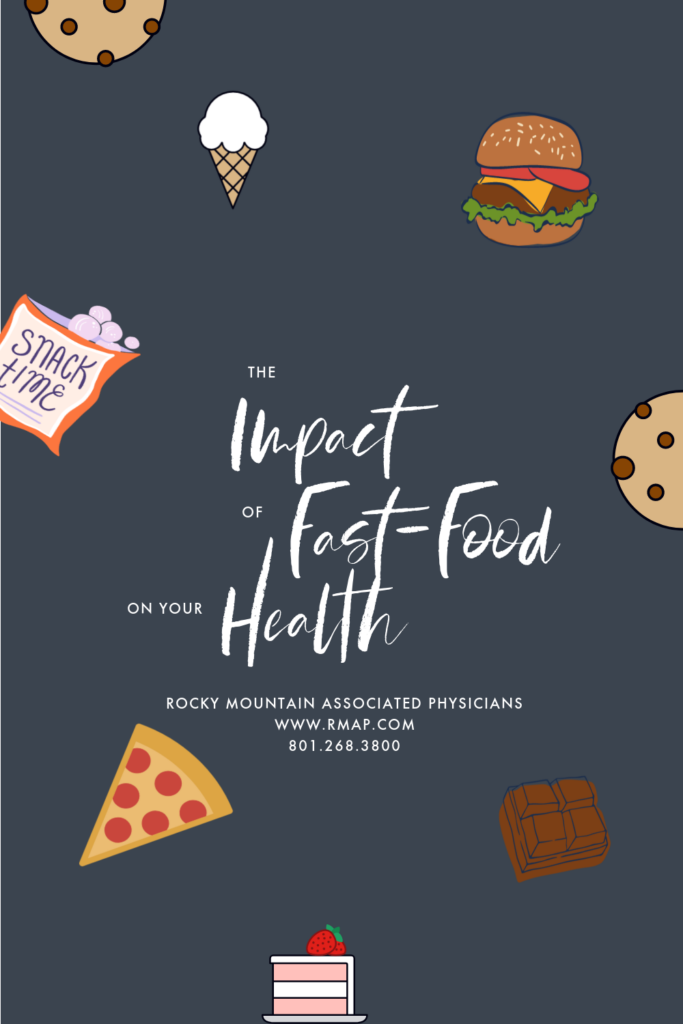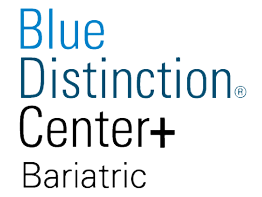
Learn more about weight loss surgery at Rocky Mountain Associated Physicians www.RMAP.com (801) 268-3800
Life is busy. It’s no secret or something new we haven’t heard before! When strapped for time or when a meal is needed to be quick or easy to feed a hungry family, many are guilty of driving through a drive-thru of a fast-food restaurant. It’s quick, accessible, and let’s be honest, someone else prepared the meal.
Even grabbing frozen meals from the grocery store to save on time is a no-no regarding your health. Frozen pre-packaged foods can sometimes be laden with sodium, added sugar, unhealthy fats, and preservatives.
What Are Fast foods?
Fast foods or “junk food” can be defined as food that is high in calories (or empty calories) with little to no nutritional value. Fast food can sometimes even be labeled as “cheap” or cheaper than healthy nutrition-dense foods, thus leading to weight gain and overweight conditions.
Over the last couple of decades, fast food has become increasingly popular. With this increase in fast food chains, obesity, and chronic diseases have never been higher. But fast food is not just the food in fast food restaurants. These foods can include chips, soda, cookies, candy, breakfast cereals, bars, French fries, burgers, pizza, white flour baked goods, and all other high-calorie, low-nutrient foods. These are processed foods and can be easily accessed. They don’t need to be prepared and easily go from a bag or box into the mouth.
Fast foods, or “hyper-palatable” foods, are specifically engineered to spark cravings, triggering brain responses that look surprisingly like the brain’s response to alcohol or even illicit drugs. They contain certain chemicals that can make us feel happy, but later depressed because they don’t contain any nutrients that our body truly needs. It can also cause digestive issues such as bloating, constipation, or even stomach pain.
Examples of a few typical fast-food items, not including drinks or sides:
- McDonald’s Big Mac: 590 calories; 34 grams of total fat
- Burger King Whopper: 670 calories; 37 grams of total fat
- Wendy’s Bacon Deluxe Double: 920 calories; 62 grams of total fat
- Taco Bell Nachos Bell Grande: 730 calories; 38 grams of total fat
Examples of sides:
- McDonald’s Medium French Fries: 320 calories; 15 grams of total fat
- Dairy Queen Onion Rings: 360 calories; 16 grams of total fat
- Popeye’s Regular Cole Slaw: 220 calories; 15 grams of total fat
Examples of drinks:
- Wendy’s Large Frosty: 407 calories; 11 grams of total fat
- McDonald’s Large Sweet Tea: 210 calories; 0 grams of total fat
- Dunkin Donuts Ice Caramel Latte: 230 calories; 6 grams of total fat
These popular food menu items are highly processed, and loaded with fat, sugar, calories, and sodium. According to the Dietary Guidelines for Americans, the recommended daily calorie intake varies depending on life stages, pregnancy, and activity level.
For bariatric patients in maintenance, the focus is still 70% protein, 30% vegetables, 3 meals a day, while slowly adding complex carbohydrates back into your diet while increasing your physical activity. Bariatric patients should never consume more than 1 cup (8 ounces) at any meal. You should be consuming 2-to-4-ounce meals. This should be measured in volume, not weight. If you have questions about what you should be eating and when, please review the big blue binder that was given to you at your surgery orientation class before your surgery. If you still have questions or are unsure, please call us at (801) 268-3800.
| ¼ cup = 2 ounces | ½ cup = 4 ounces | 1 cup = 8 ounces |
| 4 tbsp. = 2 ounces | 8 tbsp. = 4 ounces | 16 tbsp. = 8 ounces |
Effects of Eating Fast foods
Fast foods are high in calories and fats, which when eaten often or as a regular diet can lead you to feel sick or even get sick. Eating nutrition-dense foods can help your body feel good and perform daily tasks with natural energy.
The majority of fast-food meals come with a soda, which increases sugar content ten times as much. Some research has shown that the high fat and salt content in fast food may increase addictive actions.1 Fast food advertising, restaurant, and menus all provide informational cues that could prompt addictive overeating.
71% of Americans are overweight or obese; which is a staggering 100 million individuals in America2 and over 300 million worldwide. Obesity has now become a global epidemic. Obesity can lead to many other health problems, such as to name a few:
- Heart or cardiovascular disease
- Diabetes
- Fatty liver disease
- High blood pressure
Today, eating processed foods and fast foods may kill more people prematurely than cigarette smoking.3 A link may even exist between fast-food, processed food, commercial baked goods, and sweets, and the damage of brain cells to the decreasing of intelligence. Candy and sweetened baked goods can even sometimes stimulate the brain in an addictive way, which could then lead to more serious illnesses.4
Research tells us that a surplus of calories outside the daily recommendation can shorten a person’s natural life, while moderate caloric restriction has been shown to slow the aging process and protect the body and brain.5 Americans are notoriously known to consume more excess calories, and foods which have minimal to no nutritional value, than any other population.
Fast-Food Epidemic
So, is fast food the enemy? According to the Centers of Disease Control and Prevention (CDC), between 2013 and 2016 about 37%, or 84.8 million of US adults, consumed fast food on any given day.6 On average, adults in the United States consumed 11.3% of their total daily calories from fast food between 2007 and 2010. Also in the study, 44.9% of adults ages 20-39 said they consumed fast food on a given day, compared with 37.7% of adults 40-59, and 24.1% of adults 60 and older. It also showed that 31.7% of lower-income adults, 36.4% of middle-income, and 42% of higher-income said they had eaten fast food. Among those who had eaten fast food, 43.7% did so during lunch, 42% during dinner, 22.7% during breakfast, and 22.6% as snacks.
The study also said that more men (48.3%) than women (39.1%) said they ate fast food during lunch. However, more women (25.7%) than men (19.5%) said they had it as a snack. Among all adults, a higher percentage of men (37.9%) than women (35.4%) said they ate fast food on a given day. This data is based on about 10,000 people 20 and older from the CDC study 2013-2016.7
Community Efforts to Help
Let’s be honest, we can’t always avoid eating out, and we shouldn’t need to. On the rare occasion you might find yourself eating out with friends or family, remember these few tips for a healthier meal option:
Let’s be honest, we can’t always avoid eating out, and we shouldn’t need to. On the rare occasion you might find yourself eating out with friends or family, remember these few tips for a healthier meal option:
- Substitute the fries: Pick a side such as a salad, fruit, or yogurt.
- Choose calorie-free drinks: Go for water or a sugar-free beverage instead of soda.
- Grilled over fried: Grilled chicken is a healthier option instead of fried or breaded chicken.
- Limit portions: Americans are notorious for serving huge portions! Cut your meal in half and save the rest for another meal.
- Leave off the sauces: May and most other sauces can add a lot of calories to a sandwich or salad. Order your own plain or add salsa or a low-calorie dressing.
The key to helping with overeating or eating out is to meal plan and meal prep. Think about your schedule in advance and plan your meals accordingly. On days when you are constantly on the run, plan for a quick and easy meal such as:
- Salad with grilled chicken or a salad in a jar
- Turkey wraps or lettuce wraps
- Veggie rollups or sandwiches
- Boiled eggs and sliced veggies
Knowing whether a food is healthy or not typically feels like common sense or an easy judgment call. Vegetables? Yes. Potato chips? No. But it’s not always as clear-cut as it seems. According to Lauren Black, RD, LDN, CHWC, a registered dietician at Ohio State Medical Center, avoiding these eight foods that “disguise” themselves as healthy can help:
- Low-fat peanut butter: the fat that would be in the reduced-fat peanut butter spread is replaced with ingredients like corn syrup solids, sugar, and molasses, plus starchy fillers. Those add-ins boost the spread’s sugar content to 4 grams and its total carbs to 15 grams. Try natural peanut butter instead.
- Low-fat or fat-free salad dressing: Salad dressing, like peanut butter, also has healthy fat in it. It will have fat that can help you absorb nutrients from the greens in your salad. Try Greek yogurt-based dressings instead, or a vinegarette with lemon instead.
- Fake meat: Some of those products, even though they might contain high amounts of plant-based protein, may also contain unhealthy ingredients such as high amounts of sodium or unhealthy fats. Try eating lentils, beans, eggs, or nuts if you are vegetarian.
- Fast-food smoothies: Fast-food or store-bought smoothies can be high in added sugar, plus lots of simple syrups get added as well. Try a homemade smoothie if you’re craving one instead.
- Pre-packaged yogurt parfaits: Yogurt parfaits might seem like a good healthy choice, but unfortunately most are made with added sugar, refined carbs, and other high-fat or calorie ingredients. Try reaching for fresh fruit or make a parfait at home with plain Greek yogurt.
- Frozen diet meals: Frozen meals can be notoriously high in sodium and saturated fat for a smaller portioned meal. Instead, try making protein and veggies at home that can be frozen and saved for reheating later.
- Pretzels: Even though pretzels are low-fat, they are low in protein and fiber. They can also be high in sodium and carbs. Try eating nuts instead for a healthy snack.
- Fiber bars: Yes, these bars might have a little bit of fiber, but many of these bars are processed and contain additives such as sugar, preservatives, or flavorings.
Growing food at home can help you develop a lifetime habit of eating better, too. Preparing your food gives you control of what’s on your plate. With good information, emotional support, increased food availability and food preparation instruction, we all could be more enthused and willing to work together for change.
Links to related articles:
Habits Sabotaging Weight Loss
Mindset Over Weight: Resetting Your Brain
Overeating Triggers and Tips
Food Addictions and Habits
What is Junk Food?
www.RMAP.com
Rocky Mountain Associated Physicians
801-268-3800
1160 East 3900 South, Suite 4100
SLC, UT 84124
Resources:
- Andrea K Garber, Robert H Lustig; “Is fast food addictive?”; 2011 Sep; 4 (3):146-62; https://pubmed.ncbi.nlm.nih.gov/21999689/
- Centers for Disease Control and Prevention; Health, United States, 2016; 2016; https://www.cdc.gov/nchs/data/hus/hus16.pdf#053
- US Burden of Disease Collaborators; “The State of US Health, 1990-2010: Burden of Diseases, Injuries, and Risk Factors”; JAMA 2013 Aug 14; 310(6):591-608; https://www.ncbi.nlm.nih.gov/pmc/articles/PMC5436627/
- Joel Fuhrman, MD; “The Hidden Dangers of Fast and Processed Food”; 2018 Apr 3: dio:10.1177/1559827618766483; https://www.ncbi.nlm.nih.gov/pmc/articles/PMC6146358/
- Joel Fuhrman, MD; “The Hidden Dangers of Fast and Processed Food”; 2018 Apr 3: dio:10.1177/1559827618766483; https://www.ncbi.nlm.nih.gov/pmc/articles/PMC6146358/
- Cheryl D. Fryar, MSPH, Jeffery P Hughes, MPH, Kirsten A Herrick, PhD, MSc, and Namanjeet Ahluwalia, PhD; “Fast Food Consumption Among Adults in the United States, 2013-2016”; Centers for Disease Control and Prevention; https://www.cdc.gov/nchs/products/databriefs/db322.htm
- Cheryl D. Fryar, MSPH, Jeffery P Hughes, MPH, Kirsten A Herrick, PhD, MSc, and Namanjeet Ahluwalia, PhD; “Fast Food Consumption Among Adults in the United States, 2013-2016”; Centers for Disease Control and Prevention; https://www.cdc.gov/nchs/products/databriefs/db322.htm













 Address: 1521 East 3900 South STE 100
Address: 1521 East 3900 South STE 100 Office: +
Office: +  Fax number (801) 268-3997
Fax number (801) 268-3997 Email: info@rmapinc.com
Email: info@rmapinc.com



